Missouri is home to a diverse range of native animals and plants. However, many invasive and damaging species now also call the state home. Having detrimental effects on the local ecosystem, it is important to spot these unwelcome guests by understanding their appearance, control measures used, and ways to prevent further damage.
Emerald Ash Borer (Agrilus planipennis Fairmaire)
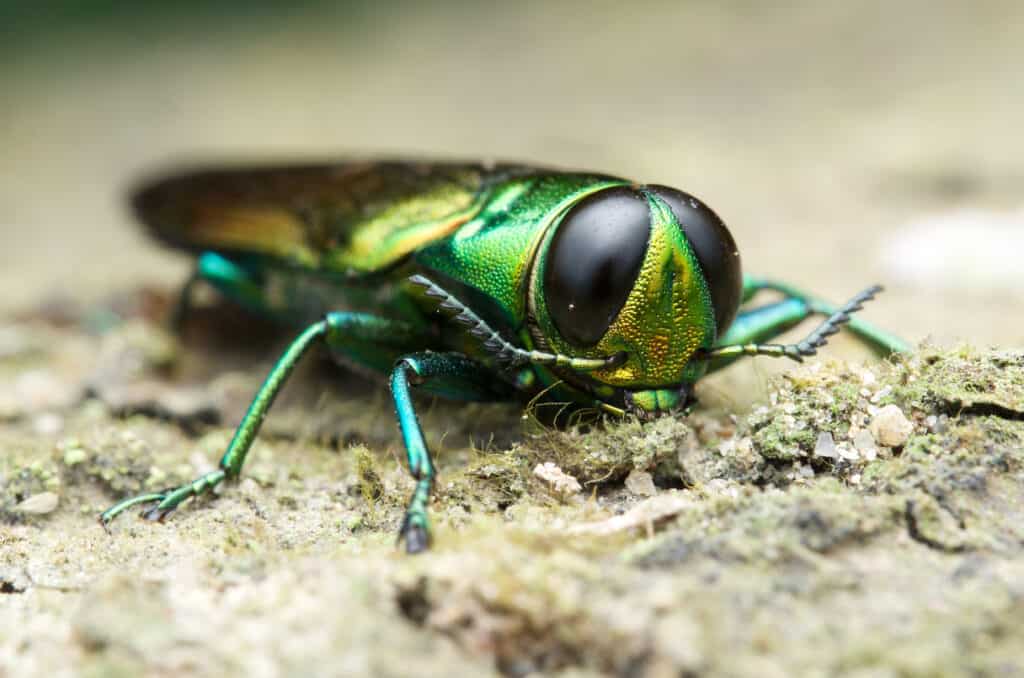
Adult
emerald ash borers
typically feed on the leaves of ash trees, while their larvae consume vascular tissue located underneath the tree’s bark.
©Herman Wong HM/Shutterstock.com
The emerald ash borer is a small beetle indigenous to the northeastern regions of Asia and has found its way to around 30 states in the USA, including Missouri. They have a distinctive metallic green coloring which makes them easily recognizable and can grow to be 0.3 inches long.
Adult emerald ash borers typically feed on the leaves of ash trees, while their larvae consume vascular tissue located underneath the tree’s bark. Back in the native regions of the emerald ash borer, some trees are naturally resistant to this troublesome beetle, helping keep their numbers in check.
However, North America has fewer resistant trees, leading to these insects swarming and infesting areas, causing the destruction of millions of trees across North America. They are also out-competing native species that also feed on ash trees.
Control measures for these insects in Missouri include planting tree species other than ash trees to reduce the overall food supply available to the emerald ash borer population, insecticides, and biological control to reduce the overall number of this invasive species.
Spongy Moth (Lymantria dispar)

The spongy moth eggs are laid in large piles and are covered in a fluffy texture, giving the species its name.
©iStock.com/Wirestock
Formerly known as the gypsy moth, this invasive insect originates from Europe and Asia. It was brought to America in 1869 and is considered one of America’s most destructive invasive insects. Female spongy moths are white with black patterns and have a wingspan between 2.3 to 3.5 inches. The males are darker brown and have a wingspan of around 1.5 inches. They also feature feathery antennae.
The spongy moth eggs are laid in large piles and are covered in a fluffy texture, while old egg piles have a spongy feeling to them, giving the species its name.
Spongy moths have been discovered in Missouri on multiple occasions. However, there have been no significant infestations yet within the state. Due to the moth’s preferred diet of deciduous trees, the forests of Missouri are a high-risk target, particularly forests with large amounts of oak trees. The damage to these trees can easily cause mass deforestation, affecting all wildlife populations within. Populations of the native saturniid moths are already feeling the negative effects of the spongy moth, as the flies and wasps that were introduced as a control method for the invasive counterpart do not strictly attack them, but any moth in the area.
Further control methods for the spongy moth include wrapping targeted tree trunks with burlap sacks to trap the caterpillars, which are then collected and destroyed. Other control methods include the use of insecticides and establishing resistant species of trees.
Asian Longhorn Beetle (Anoplophora glabripennis)

The Asian longhorn beetle typically feeds on the bark and wood of poplars, willows, maples, and various fruit trees and will lay its eggs in the bark of these trees.
©Kurit afshen/Shutterstock.com
The Asian longhorn beetle is an invasive beetle species native to China and Korea. It is thought that these beetles were introduced to the USA in wooden crates or pallets used for shipping goods from Asia. First detected in New York in 1996, this beetle has found its way to many parts of the United States, including Missouri. The beetle is relatively large and can grow up to 1.5 inches long and 0.5 inches wide. They have long antennae, which can be twice as long as their whole body, and are colored with black and white bands, while the rest of their bodies are black and shiny with white spots.
The Asian longhorn beetle typically feeds on the bark and wood of poplars, willows, maples, and various fruit trees and will lay its eggs in the bark of these trees. The larvae will burrow into the wood for food, eventually killing the tree. It is believed that in the United States, these beetles could potentially destroy a whopping 30% of urban trees.
To control the population of the Asian longhorn beetle in Missouri, the Missouri Department of Agriculture has established quarantine zones for imports from some countries and restrictions on moving hardwood firewood from infested areas in the state. It is easier to prevent the beetle from spreading than to reduce the population, so catching them early is key.
Spotted Lanternfly (Lycorma delicatula)
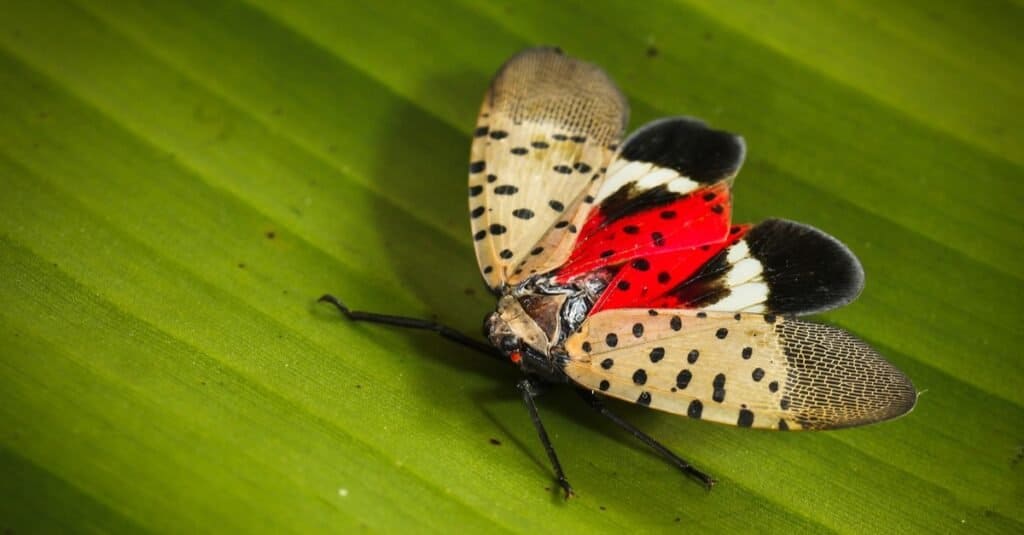
The
spotted lanternfly
feeds on the sap of over 70 different species of plants, including grapes, apples, maple, oak, and even ornamental plants.
©vm2002/Shutterstock.com
The spotted lanternfly is a large planthopper native to China. Although it has not yet been detected in large numbers in Missouri, the state is on constant watch for its eventual spread and infestation. Spotted lanternflies grow to around 1 inch long and half an inch wide and have large distinctive wings. Half of the fly is white and is covered in black spots, while the other half has a dark scaly appearance. When the lanternfly is in flight, vibrant red wings are visible.
The spotted lanternfly feeds on the sap of over 70 different species of plants, including grapes, apples, maple, oak, and even ornamental plants. They are considered invasive, as plants that are infested with large numbers will struggle to cope and eventually die. As well as damaging trees, the spotted lanternfly secrete honeydew, a sugary liquid that can cause mold on leaves and stains on cars and other surfaces.
There are currently only preventative control methods in place for this insect, and it is encouraged to report any discovery of them to the Missouri Forestry Service if you ever discover them in the state.
Starlings (Sturnidae)
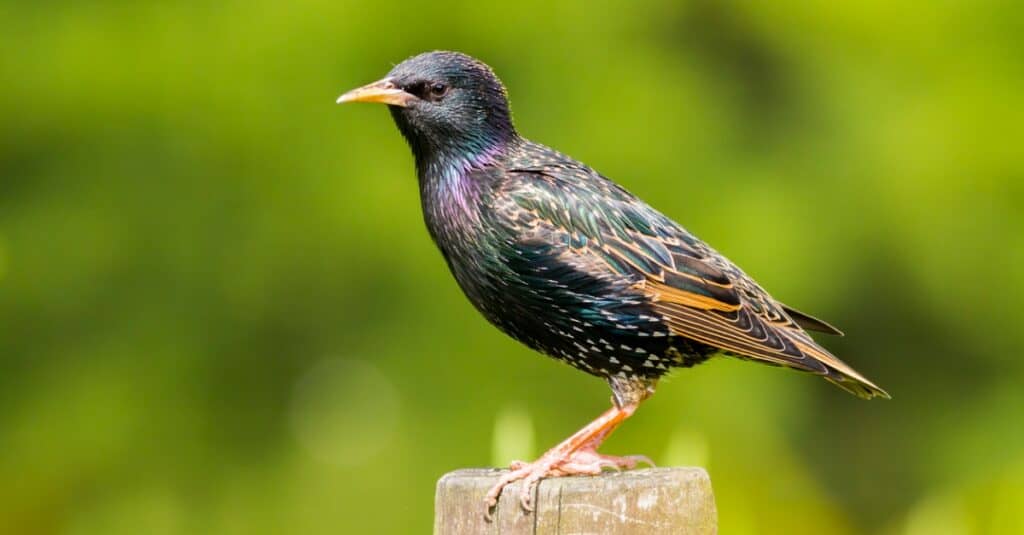
Starlings are considered an invasive species in Missouri because they compete with native birds for food and nesting sites.
©iStock.com/chris2766
European starlings are native to Europe and parts of Asia and Africa. They were introduced to New York City in 1890 and have spread throughout the United States, including Missouri, where they are considered invasive. These small birds can be easily distinguished from other black birds thanks to their stocky appearance. Their coloring changes per season, ranging from black with glossy green accents and white speckles during the fall and the loss of these speckles during the winter. In addition, they have a sharp brownish-yellow beak. The average adult size is 8.5 inches in length, and they weigh between 0.13 and 0.22 pounds.
Starlings are considered an invasive species in Missouri because they compete with native birds for food and nesting sites. Starlings are very aggressive birds that destroy the eggs and kill nestlings of many native species. They have a large appetite and eat large amounts of fruit and seeds, which can cause vast damage to crops and gardens. Because they can adapt easily to new habitats, the population of European starlings has skyrocketed. They form large swarms numbering in the thousands and can disrupt the noise these flocks make.
Trapping can be a very effective method of controlling this invasive species, especially on large-scale operations. Another method is the use of chemicals that are highly toxic to them.
Common Carp (Cyprinus carpio)

The
common carp
is considered invasive because they will out-compete native fish and increase water turbidity by uprooting aquatic foliage.
©Fabien Monteil/Shutterstock.com
The common carp is a large freshwater fish that made its way to Missouri waters from Eurasia when they were introduced in 1872. Carp are tolerant of most conditions but do prefer large bodies of slow or still water. They are most abundant in the north and west prairie streams and southwest lowlands. They are relatively large fish that can weigh anywhere from 4.4 to 30.9 lbs and are between 12 and 25 inches long. These fish have two barbels on their upper jaw and large dark gold scales, making them shiny.
Because they are omnivorous, these fish feed on a variety of different species. The common carp is considered invasive because they will out-compete native fish and increase water turbidity by uprooting aquatic foliage.
Carp removal efforts can involve the use of nets or traps. Because they are one of the most widespread and abundant large fishes in the state, this method can be very labor intensive. However, it is very effective in reducing carp populations in specific areas.
Autumn Olive (Elaeagnus umbellata)
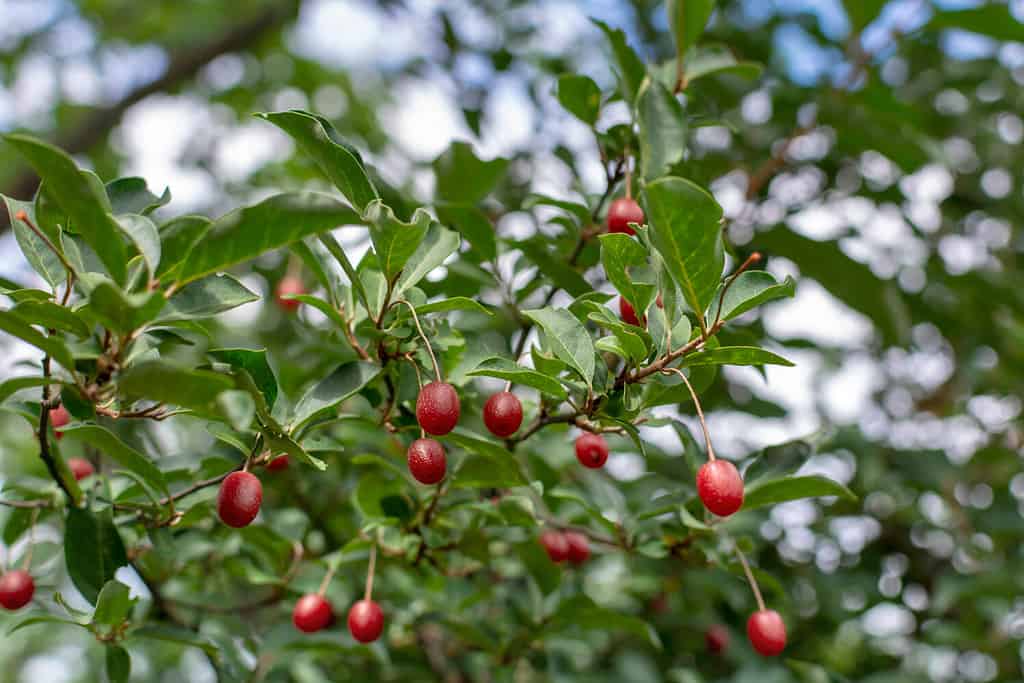
This is considered an invasive species as it outcompetes and displaces native flora.
©Oksana Shevchenko/Shutterstock.com
Autumn olive is a medium to large-sized shrub that is native to eastern Asia. This species of plant is extremely hardy and able to grow in even barren conditions. Autumn olive was introduced to the United States in 1830 for purposes that include ornamental, windbreaks, wildlife habitats, and to restore deforested lands. This plant typically grows up to 11 feet tall and has a dense crown. They also have sharp thorns and fragrant flowers that are white to yellow. When the fruit is ripe, it is red with silver or brown dots. The fruit is small, round, and juicy and ranges from ¼ to ⅓ inches.
Autumn olive is considered an invasive species as it outcompetes and displaces native flora. The plant can shade out other plant species and change the chemistry of the soil around it. Autumn olive is also easily spread into other areas as birds disperse the seeds after eating the fruit. Because this species of plant can grow in many conditions, it is aggressively invasive and difficult to control.
Control measures for the autumn olive include mechanical treatment, chemical treatment, and, most effectively, a combination of the two. Mechanical measures include cutting the plant at its main stem. Chemical measures include the use of herbicides to prevent resprouting.
Callery Pear (Pyrus calleryana)

The Callery pear is considered an invasive species as it outcompetes many native plants and trees.
©iStock.com/michaelmill
The Callery pear is native to China and Vietnam and was introduced to the United States to breed resistance to fungal disease in European pear trees. The plant is also used in landscaping as it can grow in many different conditions. It is deciduous and grows between 16 and 26 feet tall. Some varieties can even grow up to 50 feet! The leaves are oval and are a glossy dark green. The flowers are white with five petals and are produced in early spring before the leaves fully expand. The fruit produced are small and hard but are assumed to be inedible due to their cyanide-laced seeds.
The Callery pear is considered an invasive species as it outcompetes many native plants and trees. The seeds produced are easily dispersed as they can sprout and establish wherever. If not properly pruned, the Callery pear can develop weak forks, making the plant susceptible to storm damage. Because of this, further planting of this species is discouraged as it is widely used for landscaping purposes. Wild Callery pear can even develop long thorns, which make the thickets impenetrable.
Control methods to limit the spread of the Callery pear include removing trees, cutting trees, and planting alternative native trees. Small trees in light infestations can be removed by hand while the soil is moist. The entire root must be removed, so the removal of the tree must be done with care. Medium to large trees can be cut, and stumps must be treated with herbicide to prevent resprouting. Lastly, instead of using the Callery pear for landscaping, native trees should be used instead. Native trees that can be an alternative include American plum, flowering dogwood, and hawthorn.
Chinese Yam (Dioscorea polystachya)
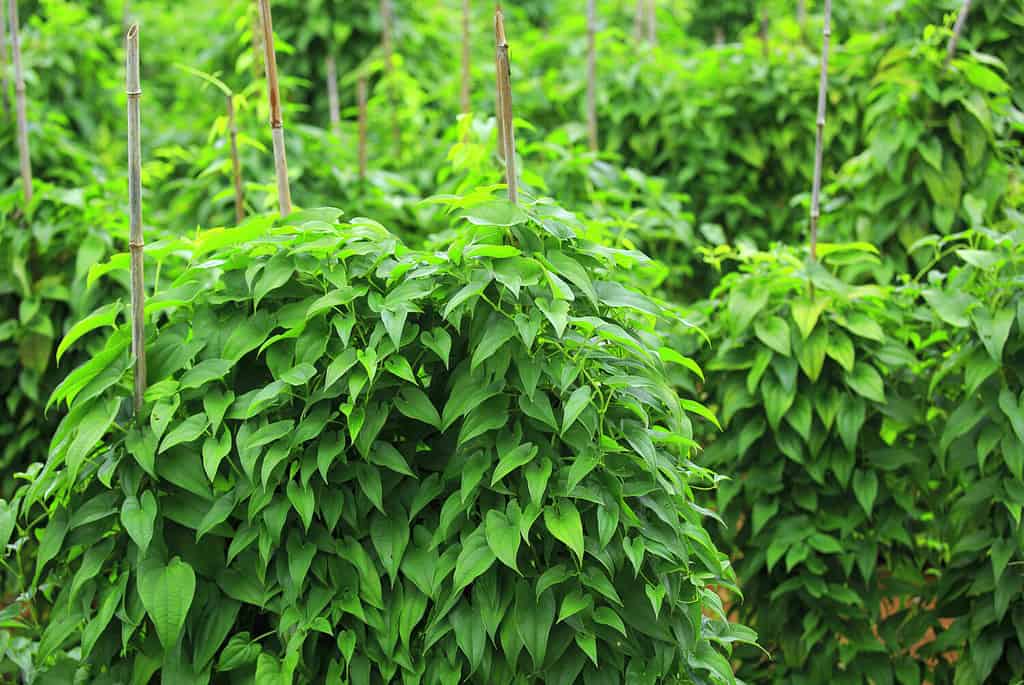
The Chinese yam outcompetes and displaces native plants, which reduces plant diversity.
©lzf/Shutterstock.com
Chinese yam is a vine native to China and was introduced to the United States for food, ornamental, and medicinal uses. This plant is also commonly known as the cinnamon vine and air potato. This climbing vine can grow between 9.8 and 16.4 feet long but can grow even longer. The leaves of the plant are long and wide – they can grow up to 4.3 inches. The flowers produced are distinct as they smell like cinnamon. They produce one or more cylindrical tubers that can grow one meter underground! These tubers are unique as they can be eaten raw.
This species of plant is considered invasive as it can smother plants on the ground blocking access to light. The vines or the Chinese yam are heavy and can break the limbs of large trees. The Chinese yam outcompetes and displaces native plants, which reduces plant diversity. Because even a small piece of a bulbil can sprout into a new vine, this plant can continue to spread and become invasive in other areas.
Control measures for this plant include mechanical control and herbicides. Mechanical control is very difficult due to the plant’s deep roots. This method is only recommended for small populations. Resprouting can occur if all tuber pieces are not removed so it is important to remove the tuber carefully when using this method. The use of herbicides has been effective in controlling the spread of the Chinese yam. The best time to use this method of control is after the leaves of the Chinese yam have expanded but before the bulbils ripen.
Garlic Mustard (Alliaria pegiolata)

The garlic mustard is considered invasive as it can outcompete native vegetation and can quickly colonize areas.
©Martin Fowler/Shutterstock.com
Garlic mustard is a flowering plant that is native to Europe. This plant was introduced to the United States in 1868 to use as a culinary herb. This plant has now spread across most states, Missouri included. The garlic mustard is unique as all parts of the plant smell like garlic. This species can grow stalks that are 2 to 3 feet tall which are covered with small white flowers in May. The garlic mustard inhabits upland and floodplain forests, savannas, and even along roadsides. It can live in shaded areas, open woodlands, and even in full sun. The large number of seeds dispersed from the plant enables the incredible spread.
The garlic mustard is considered invasive as it can outcompete native vegetation and can quickly colonize areas. The seeds of the garlic mustard are spread by animals, flowing water, and human activities. Because this plant can dominate the understory of forests, it has reduced biodiversity in many areas.
Control measures used to eradicate the garlic mustard include pulling, cutting, burning, and applying herbicides. Pulling is generally used for new infestations and small populations and is very effective before seed dispersal. Cutting is used after flower stalks have elongated and before flowers have opened. By repeating the method each year, you will exhaust the seed bank. Prescribed burns and the use of herbicides in spring or fall can help eliminate the invasive plant.
Japanese Honeysuckle (Lonicera japonica)

Don’t be fooled by this plant’s an amazing scent and beautiful flowers, as it is incredibly invasive and banned in some states.
©Aftabbanoori / Creative Commons – License
The Japanese honeysuckle is a vine native to Japan and was introduced in 1806 as an ornamental ground cover. This invasive species is found in large areas across Missouri. This twining vine can climb up to 33 feet high or more in trees. The leaves are oval and are between 1 and 3 inches long and 0.8 and 1.2 inches wide. When its stems are young, they can have red coloration with fuzz. Older stems are brown and often hollow on the inside. The flowers are beautiful white and yellow with a sweet vanilla scent. The fruit of the Japanese honeysuckle is a blackberry that contains a few seeds.
Don’t be fooled by this plant’s an amazing scent and beautiful flowers, as it is incredibly invasive and banned in some states. This plant species is considered invasive as it grows extremely rapidly and outcompetes native plants. Because the plant can form a dense thicket, it prevents other plant species from germinating in the area. The Japanese honeysuckle is also capable of preventing the regeneration of trees. Not only that, this plant can alter bird populations in forest communities.
There are many ways to control the spread of Japanese honeysuckle. These methods include mowing, grazing, burning, and herbicides. However, these methods are not always effective. Mowing and grazing do limit the length of the vines but will increase the number of stems produced. The most effective way to stop the spread of this plant is to use a combination of prescribed burns and herbicide spraying.
The photo featured at the top of this post is © Martin Fowler/Shutterstock.com
Thank you for reading! Have some feedback for us? Contact the AZ Animals editorial team.







